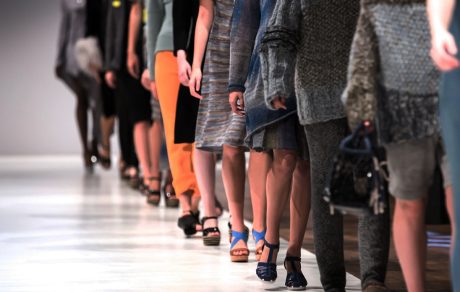Coco Chanel is credited with saying: “In order to be irreplaceable one must always be different.” Unfortunately for the world’s great brands, copycats have little desire to be different and often tread the fine line between ‘inspiration’ and copying. In this article, Oliver Fairhurst discusses how designers are able to protect their brands and products using the rights available to them.
As a general rule, intellectual property (IP) rights protect the expression of ideas, and not the ideas themselves. This can be problematic for fashion designers, whose original designs can sometimes represent both an expression of a concept and a concept itself. While the distinction between an idea and the expression of that idea is often dependent on perspective, especially in fashion, designers have a range of rights that they can rely on to protect their work, including copyright, design rights and trademarks.
Copyright
To be protected as a copyright work in the UK, the item or design must fall within the list of protected works contained in the UK’s copyright legislation, the Copyright, Designs and Patents Act 1988 (the “CDPA”). The category of copyright work potentially applicable to fashion designs is that of “artistic” works, which covers (among others) “graphic works” and works of “artistic craftsmanship” (as defined in CDPA, ss.1 and 4).
Copyright can certainly protect a print design. Copyright will prevent a copycat from copying a drawing, image or graphical design appearing on a product (or a substantial part of it), provided it is sufficiently original.
However, the English courts have traditionally been reluctant to grant copyright protection to garments themselves (eg dresses, shirts, etc.) as the courts have not considered them to be “works of artistic craftsmanship”, meaning that they do not qualify as artistic works.
This has even been the case when the garments in question were displayed in an exhibition at London’s Victoria & Albert Museum (the case of Shirin Guild v Eskandar Limited (Formerly Known as Ambleville Limited), Eskandar Nabavi (Trading As Eskandar) [2001] F.S.R. 38.). In that case, the judge held that he was not satisfied that the garments concerned “can reasonably be regarded as works of craftsmanship. There is no evidence of any special elements of craftsmanship going into their manufacture, I do not consider anyone would regard that as a natural way to describe them, and my instinctive reaction is that they are not works of craftsmanship.” Further, the fact that a designer considers themself to be an artist and that they might consider their designs to be works of art does not “justify an inference that the garments are to be regarded as works of art”. These conclusions are likely to be met with some incredulity by many fashion designers, especially those of luxury items.
The fact that fashion pieces have not been considered to constitute works of artistic craftsmanship does not mean to say that they will never be so. One-off pieces and haute couture items could fall within that description and attract copyright protection; each case will depend on its facts.
The UK approach is arguably more restrictive than the test laid down by the Court of Justice of the EU (“CJEU”), which requires only that the work in question reflects the “author’s own intellectual creation” (Case C-5/08 Infopaq International A/S v Danske Dagblades Forening). The CJEU has in subsequent cases elaborated on that test, requiring the author to have made “free and creative choices” and that the work reflects the “author’s personality” (Case C‑145/10 Painer). It is hard to imagine why the design of a fashion piece would not meet that threshold, but the position in the UK is that it must fall within the definition of a “work” (ie an artistic work by being a work of artistic craftsmanship) and the courts have found that often they do not.
Design rights
The law of designs in the UK currently consists of up to four separate rights (in addition to copyright, which has limitations as explained above). Those rights are UK registered and unregistered design rights, and Community registered and unregistered design rights.
Registered designs
As the name suggests, the UK and Community registered design rights require their owners to have registered the designs. Both protect “the appearance of the whole or a part of a product resulting from the features of, in particular, the lines, contours, colours, shape, texture and/or materials of the product itself and/or its ornamentation” (regulation (EC) No 6/2002, Article 3(a); Registered Designs Act 1949, s. 1(2)).
Designers can register their designs in a variety of different ways. The trick to doing so is to give the registered design the widest scope of protection without allowing copycats to tweak the design so as to avoid a claim for infringement. The best-known recent case showing this balance is PMS v. Magmatic (the Trunki case – PMS International Group Plc v Magmatic Limited [2016] UKSC 12), in which the Supreme Court (with some regret) agreed with the Court of Appeal that the copycat product created a different overall impression to that created by the registered design and that, accordingly, there was no infringement.
The court noted that the defendant had deliberately created a discount version of the original “Trunki” ride-on suitcase. However, the court explained that design rights are intended to protect designs rather than ideas, and that the discount version was sufficiently different to create a different overall impression. This case was widely considered to be a damaging blow to design-led businesses and a major boost to copycats.
The use of registered designs has sometimes been limited to high-value, premium and iconic designs that are most likely to be copied, with many designers relying on unregistered design rights to protect short-lived, seasonal designs.
Unregistered designs
The UK unregistered design right protects the design of the shape or configuration of an item, but it does not protect “surface decoration” (CDPA, s. 213). This has been held by English courts to include embroidery (the case of Jo y Jo Ltd v Matalan Retail Ltd [2000] E.C.D.R. 178). It therefore only really protects the 3D shape of a product, which limits its use in preventing copycats.
The Community unregistered design right is often of much greater assistance to designers. While it only lasts for three years, it creates a broader scope of protection by covering surface decoration, colour and texture. As the right arises automatically (without the need to register it), it gives good short-term protection over creations.
Trade marks and passing off
A trade mark can be registered to protect pretty much anything that is capable of both distinguishing the goods or services of one undertaking from those of another and being represented on the trade marks register. Recent reforms were intended to make it easier to register “non-traditional” trade marks, including more exotic trade marks such as the smell of a perfume. Unfortunately for brands though, the EUIPO and EU courts have made it increasingly difficult to register (or maintain the registration of) such trade marks, and in particular those seeking to protect the shape of a product. The Kit Kat judgments have perhaps grabbed the most media attention, but they form only a part of an overall body of case law where shape marks have been refused or invalidated.
However, brands are able to register shapes where they either depart significantly from the norm (such that consumers will see goods in that shape as coming from a particular brand) or that the public has come to perceive goods conforming to a particular shape as coming from a particular entity. In a recent positive decision for designers, the Court of Justice of the EU decided that Louboutin’s registered trade mark for the famous red sole could function as a trade mark (Case C-163/16 Christian Louboutin and Christian Louboutin Sas v van Haren Schoenen BV).
Finally, passing off allows the owner of goodwill in a brand name or ‘get-up’ to prevent another from misrepresenting that its goods or services are those of the owner of the goodwill. Passing off can be particularly useful when a designer does not own any registered rights. Rihanna famously (and successfully) sued Topshop for using an image of her on a garment (Fenty v Arcadia Group Brands Ltd (t/a Topshop) [2015] EWCA Civ 3). If a designer is known for using a certain sign or feature, its use by a competitor could constitute passing off.
Enforcement of rights
Most brands are familiar with the process of litigating IP rights. Generally, the rights holder alleges that a product somehow infringes the right and the defendant says that it does not (and/or that the right is invalid). In the case of trade mark litigation, this might be that a particular logo being used is confusingly similar to and/or takes unfair advantage of the registered mark. With registered and unregistered designs, it might be that the defendant’s product creates the same overall impression as the earlier product.
The UK courts are well equipped to deal with IP disputes. In particular, the Intellectual Property Enterprise Court (IPEC) was established in 2013, having formerly been the known as the Patents County Court. The IPEC has become well established as a quick and lower-risk forum for bringing relatively simple, and relatively low value (less than £500,000) IP disputes. The IPEC draws on IP specialist judges, a streamlined procedure and a costs cap, all of which have been popular with rights holder seeking to enforce their rights. For fashion brands in particular, this can be an excellent forum as it allows brands to bring proceedings and have a trial in as little as seven months.
For more complex and/or high-value disputes, the UK High Court has a good number of IP specialist judges, as well as innovative procedural rules that allow claims to be brought more quickly and at lower cost than was previously the case. For example, the Shorter Trial Scheme was used earlier this year in a claim by L’Oréal in relation to its patent and Community registered designs (L’Oréal Societe Anonyme & Anor v RN Ventures Ltd [2018] EWHC 391 (Ch)).
Counterfeiting
When it comes to counterfeiting, bringing legal proceedings against the counterfeiter can be a real challenge. Brands often end up chasing their tails as the sellers’ websites ignore threats, switch hosts and operate out of jurisdictions that do not facilitate IP enforcement.
As a result, rights holders have been increasingly making use of so-called “blocking injunctions”. These injunctions involve the major internet service providers being ordered to block certain websites and/or servers. They originated in copyright law and were used to prevent, in particular, the sale or streaming of illegal content such as films and TV programmes (CDPA, s. 97A). However, they have over the last few years begun to be used by trade mark proprietors and now form a settled part of the brand-owner’s armoury (See Cartier International AG & Ors v British Telecommunications Plc & Anor [2018] UKSC 28). Further, there is no reason in principle why such injunctions could not be sought in relation to design infringements as they have been for trade mark and copyright infringements.
Designers and brands have a range of tools at their disposal. Those that manage their brands properly increase the value of those brands. Those that do not often find that their creativity and reputation is exploited by others.
Post-script: Note on Brexit
Copyright
Copyright is a national right and will continue to exist post-Brexit. However, UK law has been extensively influenced by EU jurisprudence, and it is likely that the UK and EU approaches will diverge further over time. The question over whether the potential difference in the level of copyright protection under UK law complies with EU law may never be finally resolved, leaving designers stuck with the limited protection afforded to fashion products under the CDPA.
Design rights
Much of the fashion industry is concerned about the effect of the UK’s exit from the EU on design rights. The concern is two-fold: first, that the Community unregistered design right (absent any agreement to the contrary) will no longer apply in the UK; and second, that designers exhibiting their new designs in London will not qualify for the Community design right as the design would have first been made available to the public outside of the EU. The validity of the second concern is up for debate, but the lack of an unregistered design right that protects surface decoration is a real concern.
Trade marks
Modern UK trade mark law is derived from EU law (although it has its origins long before the EU came into existence). It is very likely that UK trade mark law will remain aligned with EU trade mark law for some time. However, there is likely to be some divergence unless the UK agrees to a deal that keeps its trade mark law bound to that of the EU (which seems unlikely given the UK government’s antipathy towards the CJEU).
However, as a positive for brands, products sold on the EEA market outside of the UK will no longer have had their rights “exhausted”, meaning that brands will be able to prevent sales and imports of genuine products into the UK from the rest of the EEA.
Enforcement
The departure of the UK from the EU may also affect anti-counterfeiting efforts. Rights holders benefit from the cooperation at international level, including between the customs and enforcement authorities across the EU. Absent any deal to preserve the UK’s participation in that cooperation, brands are likely to suffer through increased counterfeiting.
You can find further information regarding our expertise, experience and team on our Intellectual Property Disputes page.
If you require assistance from our team, please contact us or alternatively request a call back from one of our lawyers by submitting this form.
Subscribe – In order to receive our news straight to your inbox, subscribe here. Our newsletters are sent no more than once a month.




